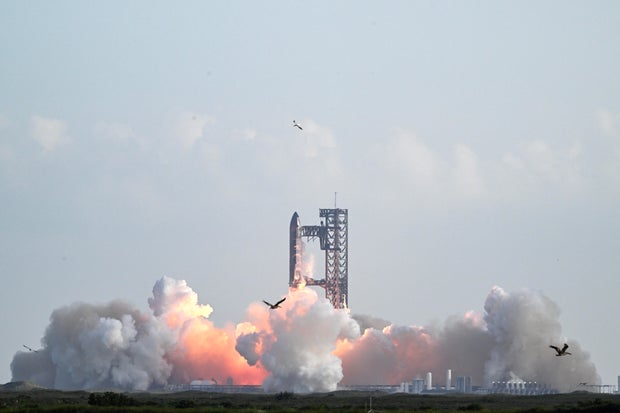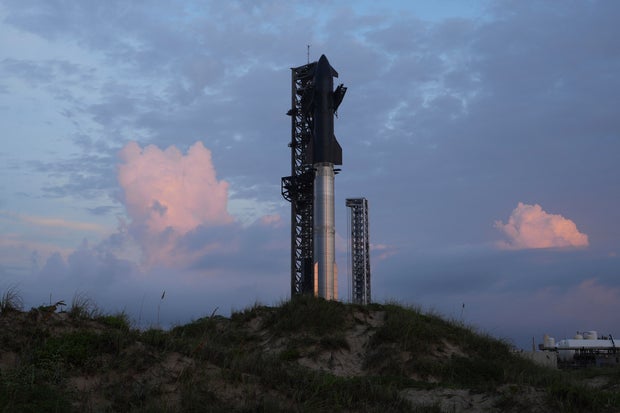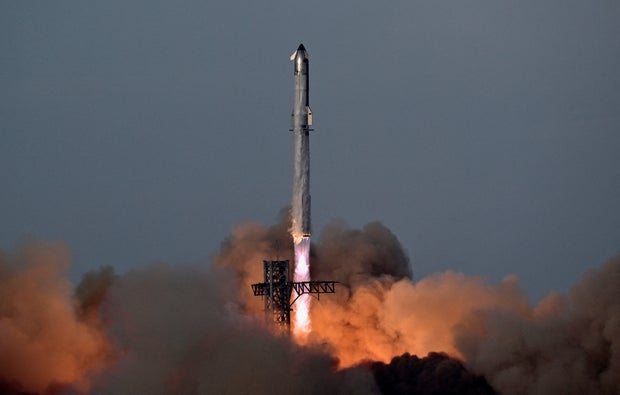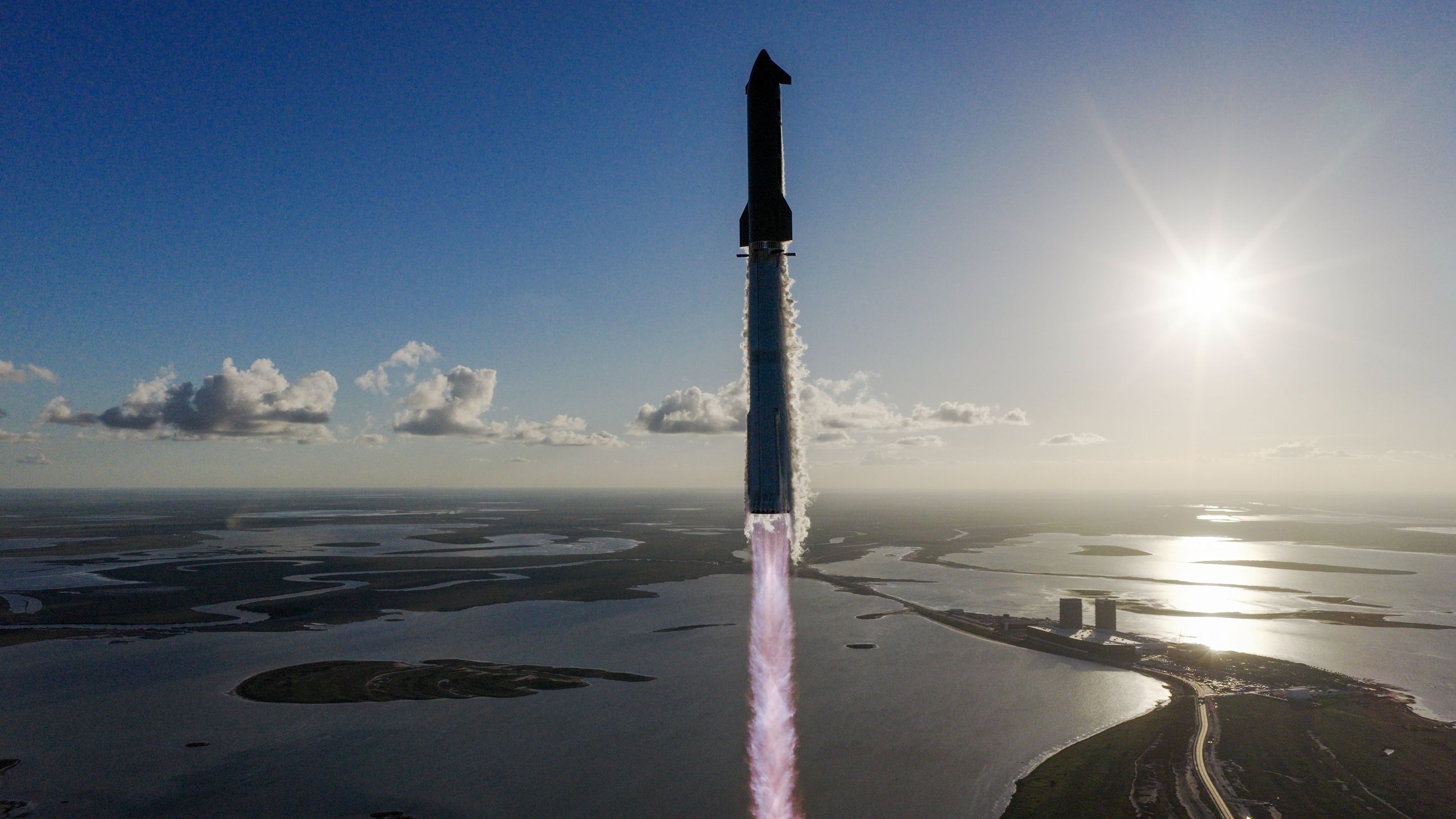Running two days late, SpaceX finally launched its huge Super Heavy-Starship on Tuesday on a high-stakes return-to-flight after three catastrophic failures in a row earlier this year.
The Super Heavy booster’s 33 methane-fueled Raptor engines flashed to life with a ground-shaking roar and a rush of flaming exhaust at 7:30 p.m. ET, majestically pushing the 40-story-tall rocket away from SpaceX’s Starbase facility on the Texas Gulf Coast.
A launch try on Sunday was called off because of trouble with ground equipment, and a second attempt Monday was blocked by cloudy weather.
But it was clear sailing Tuesday as the rocket, the most powerful ever built, put on a spectacular show accelerating toward space atop some 16 million pounds of thrust — more than twice the power of NASA’s Space Launch System moon rocket and the agency’s legendary Saturn 5.
RONALDO SCHEMIDT/AFP via Getty Images
Given the Super Heavy-Starship’s uneven track record to date, concern has been growing that a moon lander variant of the Starship being built for NASA may not be perfected in time for a planned 2027 landing and possibly not before the Chinese plant their own flag on the moon at the end of the decade.
But the initial stages of the 10th Super Heavy-Starship test flight appeared to go smoothly. The 230-foot-tall Super Heavy booster propelled the Starship upper stage out of the dense lower atmosphere, separated, flipped around, and flew itself to a splashdown off the Texas Gulf Coast as planned.
The stage is designed to fly itself back to its launch gantry for a mid-air capture by giant mechanical arms, a feat pulled off three times during earlier testing.
But for Tuesday’s flight, the booster targeted the Gulf while flight controllers monitored how it performed when engines used for landing were deliberately shut down, forcing a switch to backups, to simulate failures. The stage appeared to perform smoothly all the way to splashdown.
The Starship upper stage, meanwhile, flew into a suborbital trajectory as planned, heading for a splashdown in the Indian Ocean 1 hour and 6 minutes after liftoff.
Eric Gay / AP
During the previous three flights earlier this year, the Starship stage was destroyed during ascent by propellant leaks, engine shutdowns and a loss of control. It appeared to perform as designed on Tuesday, reaching engine cutoff as planned nine minutes after launch.
Over the next 50 minutes, the flight plan called for the launch of eight Starlink satellite simulators to test the Pez-like deployment mechanism and reignition of one of its six Raptor engines to verify it can restart normally in space.
Then, during reentry into the lower atmosphere, SpaceX planned to test new heat shield tiles and measure how much heat the underlying skin of the rocket can withstand in the absence of a tile.
Like the Super Heavy booster, the Starship is designed to fly itself back to a launch gantry for midair capture. But SpaceX has not yet attempted a return-to-launch-site with a Starship, and the rocket instead splashed down tail-first in the Indian Ocean.
Steve Nesius / REUTERS
A successful test flight was critical to SpaceX, which wants to work the bugs out as soon as possible and get the rocket flying on operational missions to launch scores of Starlinks and other satellites and eventually to carry settlers and equipment to Mars.
The test flights are also critical to NASA, which is counting on a modified version of the Starship to carry two astronauts to the moon’s surface as early as 2027.
Because the rocket is fully reusable, the moon lander will use all of its propellant just reaching low-Earth orbit. To send it to the moon, SpaceX will need to launch 10 to 20 Super Heavy tanker flights to refill the lander’s tanks with the needed propellant.
It will also need to somehow counteract the natural warming of the liquid oxygen and methane fuel that otherwise will cause the propellants to “boil off,” turning into a gas that must be vented overboard.
No orbit-class rockets have ever demonstrated the sort of rapid-fire launch cadence that will be required, or carried out the autonomous transfer of thousands of gallons of cryogenic propellants from one rocket to another in the weightless environment of space amid extreme temperature swings.
A single launch failure almost certainly would result in cancellation of a moon mission while an investigation ran its course. And an explosive failure in low-Earth orbit would result in a huge cloud of dangerous debris.
Safely landing on the moon with a 16-story-tall rocket presents its own challenges, not least of which is the possibility of uneven terrain or loosely packed soil that could result in a tip over. And the astronauts will have to ride an external platform down to the surface 100 feet or so below the upper crew section.
Most observers believe SpaceX will eventually overcome those hurdles. The question is, can the company do it in time for a 2027 moon landing? Or if not, will the rocket be ready to carry astronauts to the moon before the Chinese plant their own flag on the surface by the end of the decade?
CBS News interviewed multiple current and former NASA and contractor managers and engineers in recent weeks who unanimously agreed a landing in 2027 could not be safely carried out with the current HLS architecture. And not one of them said they believed NASA could get there before the Chinese without a drastic change of course.
“I think the folks you’ve talked to are accurate. We are not going to go ahead and get a crewed Starship to the moon by 2030, under any circumstances,” a senior engineer who worked on the Artemis program said. “That doesn’t mean they’ll never get there. That doesn’t mean the architecture couldn’t work. But it’s just too big of a technical leap to accomplish in the short time that we’ve got.”
Source link




